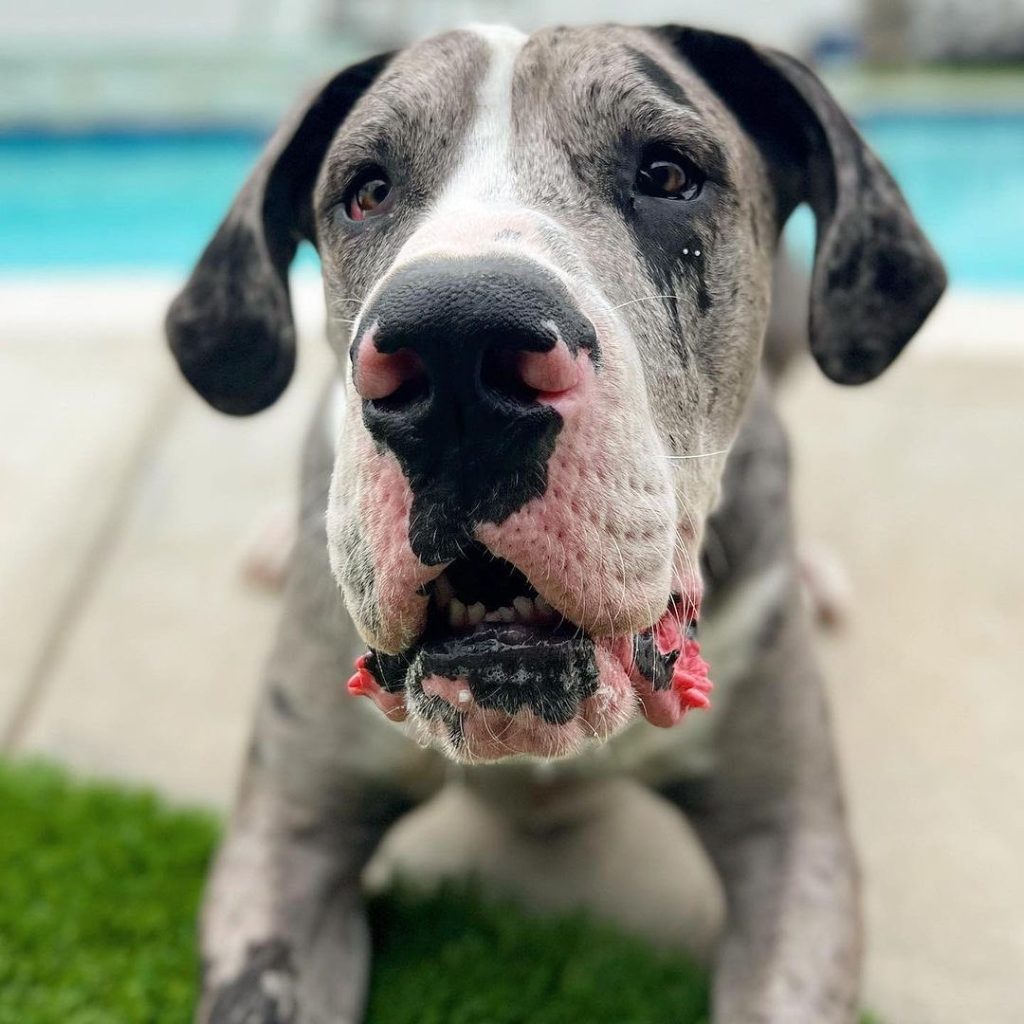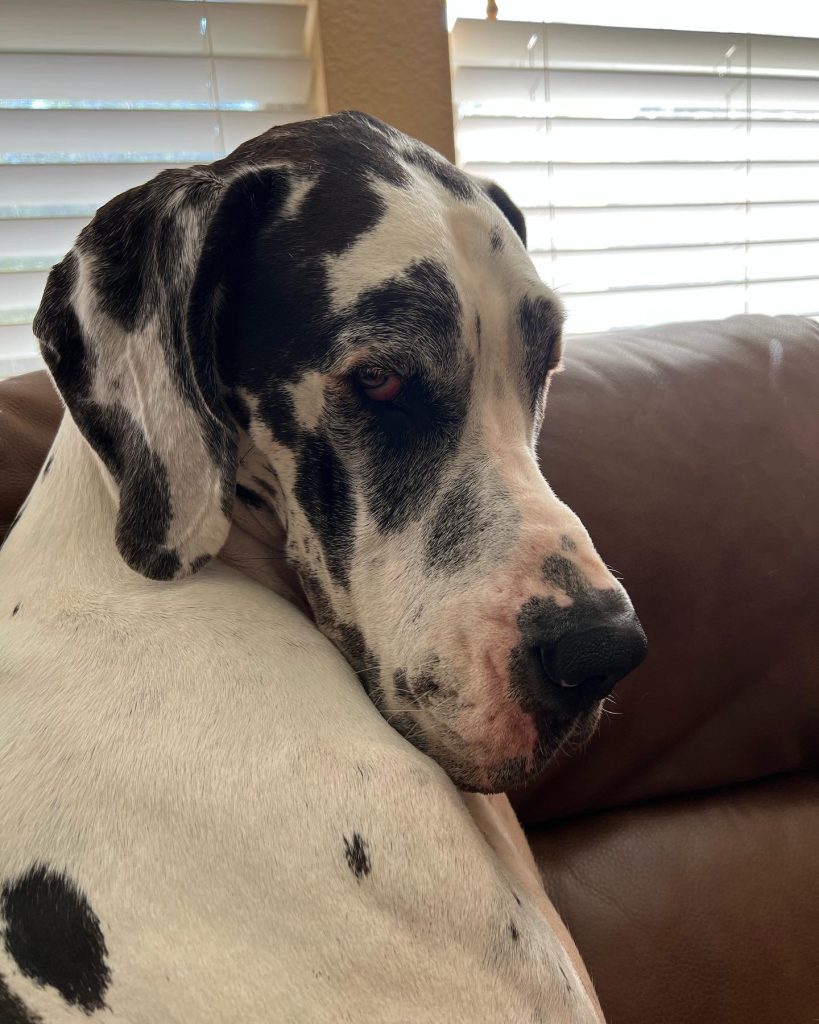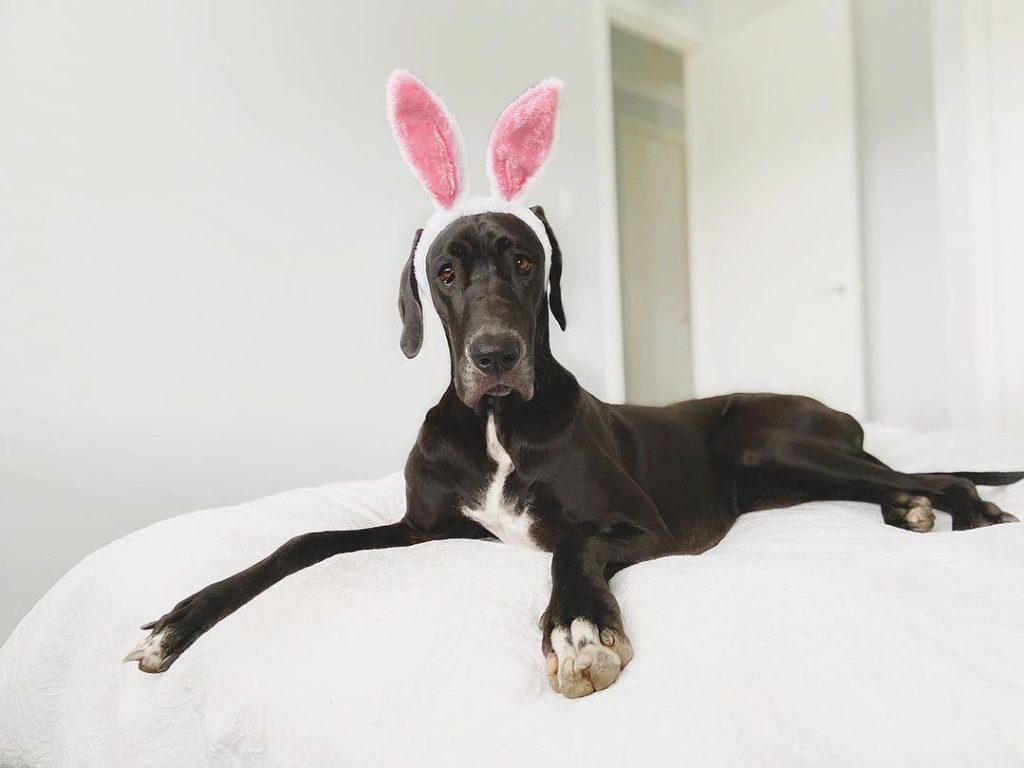
Great Danes are among the most recognizable dog breeds in the world, towering over most other dogs and even out-sizing some humans when they stand on their hind legs. Their imposing stature, however, belies a gentle giant with a loving and affectionate nature. These dogs combine dignity and strength with elegance and a friendly demeanor, making them beloved companions to those who have the space and time to accommodate their needs.
Quick Facts
Great Danes, often called the “Apollo of Dogs,” are renowned for their colossal size. Adult males can stand at the shoulder 30 to 34 inches tall, while females are slightly smaller. Despite their large size, they are known for their graceful movement and peaceful temperament. These dogs come in various coat colors, including fawn, brindle, blue, black, harlequin, and mantle. Learning about the characteristics and history of the Great Dane breed can provide valuable insights into their temperament and care requirements.
Understanding the Breed’s Popularity
The popularity of Great Danes extends far beyond their impressive physical attributes. Their temperament is a significant factor, as they are known for being friendly, patient, and dependable. Great Danes are often described as gentle giants and are usually excellent with children and pets. Their majestic appearance and warm, affectionate nature have won them many admirers and make them a sought-after hunting dog breed for families and individuals alike, willing to take on the responsibility of a large pet.
The Great Dane Personality Essentials
Understanding the essentials of Great Dane dog care is crucial for anyone considering adding one of these magnificent animals to their family. Due to their unique size, temperament, and health needs, Great Danes require specific attention in various areas to ensure they lead happy, healthy lives.
Breed Great Dane Temperament
Height and Weight
Great Danes are one of the tallest breeds in the canine world. Males typically stand between 32 and 36 inches from paw to shoulder, while females are slightly shorter, usually 30 to 34 inches. Weight can vary significantly based on height, diet, and exercise, but most Great Danes weigh 110 to 180 pounds, with some males exceeding 200 pounds. Their size is one of their most distinguishing characteristics, contributing to their regal and imposing presence. Great Dane rescue organizations often play a crucial role in providing care and finding homes for these majestic dogs in need.
Life Expectancy
Despite their large size and robust appearance, Great Danes have a relatively short lifespan compared to smaller dog breeds. On average, a Great Dane’s life expectancy ranges from 7 to 10 years. This shorter lifespan is expected among larger dog breeds, making early and consistent health care and preventive measures even more critical for these gentle giants. Name Great Dane owners should be vigilant about monitoring their pet’s health and providing proper care to ensure they live a full and healthy life.
Dog Breed Traits

Personality and Behavior
Great Danes are known for their gentle and affectionate nature. They are often called “gentle giants” due to their calm and friendly disposition towards their family and strangers. Despite their size, they are playful and quite sensitive, often seeking human companionship and affection. They are loyal to their families and can be protective, making them excellent watchdogs, although addressing Great Dane needs for proper training and socialization is crucial to ensure they develop into well-behaved companions.
Adaptability and Great Dane Training
Great Danes are generally adaptable dogs, capable of thriving in various living conditions as long as they have enough space to move around comfortably. They are well-suited to family life and can adjust to living with other pets if properly socialized. Training a Great Dane requires patience and consistency, as their size makes it crucial for them to learn manners and obedience early on. They respond well to positive reinforcement techniques, such as praise and treats, making them relatively easy to train despite their imposing size.
Health and Grooming Needs
Great Danes have specific health and grooming needs that owners must be prepared to address. Their large size predisposes them to specific health conditions, such as hip dysplasia, cardiac issues, and bloat, which can be life-threatening without proper preventive measures. Finding reputable German breeders who prioritize health screenings and responsible breeding practices can help mitigate these risks and ensure the well-being of Great Danes.
Recommended Health Tests
To maintain the health of a Great Dane, it’s recommended that several health tests be conducted throughout their life. These include hip and elbow dysplasia evaluations, cardiac exams, and eye checks to screen for common conditions affecting this breed. Regular veterinary visits are crucial for early detection and management of potential health issues.
Grooming Essentials
Great Danes have a short, sleek coat that is relatively low-maintenance. Regular brushing, at least once a week, can help reduce shedding and keep their coat healthy. They do not require frequent baths, but keeping their nails trimmed, ears cleaned, and teeth brushed is essential for their overall well-being. Despite their minimal grooming needs, their size can make these tasks more challenging, requiring more time and effort than smaller breeds. Considering that the Dane is a German breed, understanding their grooming requirements and dedicating time to their care is crucial for keeping them healthy and comfortable.
Living With a Great Dane
Great Danes are wonderful companions that bring joy and grandeur to a household. However, their size and energy levels necessitate specific considerations to ensure a harmonious living environment. From exercise to nutrition, training, and socialization, understanding what it takes to care for a Great Dane is essential for their health and happiness.
Exercise Requirements
Great Danes require regular exercise to maintain their health and prevent boredom. Despite their size, they do not need excessive exercise but benefit from a well-structured routine:
- Daily Walks: At least 30 to 60 minutes of walking daily, divided into two walks to keep them stimulated without overexerting them.
- Playtime: Play sessions in a securely fenced area or yard allow them to stretch their legs and burn off energy.
- Moderation is Key: Due to their size, it’s crucial to avoid intense exercise, especially in puppies, to prevent strain on their developing joints.
- Mental Stimulation: Puzzle toys and training sessions provide mental exercise, reducing the risk of boredom and associated behaviors.
Nutrition and Diet

The nutritional needs of a Great Dane are significant due to their size, but it’s essential to balance quantity with quality:
- High-Quality Diet: Feed them high-quality dog food that meets the nutritional needs of large-breed dogs, focusing on a balanced intake of proteins, fats, and carbohydrates.
- Portion Control: Avoid overfeeding to prevent obesity, which can exacerbate health issues like joint problems. Consult with a vet for personalized feeding guidelines.
- Feeding Schedule: Divide their daily food intake into two meals to reduce the risk of bloat, a serious health risk for Great Danes.
- Supplements: Some may benefit from supplements like glucosamine for joint health, but always consult a vet before adding supplements to their diet.
Training and Socialization
Training and socialization are crucial for living harmoniously with a Great Dane, ensuring they are well-behaved and comfortable in various situations:
- Early Training: Begin obedience training, focusing on basic commands like sit, stay, and come. Positive reinforcement methods work best.
- Consistent Boundaries: Set clear rules and boundaries to manage their size and strength within a household effectively.
- Socialization: Expose them to different people, pets, and environments early to foster a well-adjusted and confident demeanor.
- Professional Guidance: Consider professional training classes or a trainer experienced with large breeds for the best outcomes.
Kid-Friendliness and Behavior Around Other Dogs
Great Danes are known for their gentle nature, making them excellent family pets:
- Gentle with Children: They are typically patient and gentle with kids, but their size requires supervision to prevent accidental knocks or falls.
- Social with Dogs: With proper socialization, they generally get along well with other dogs. Introduce them gradually and in controlled settings to foster positive interactions.
- Respect Individual Personalities: Like all dogs, individual Great Danes have unique personalities. Some may be more outgoing, while others are reserved, so tailor socialization efforts to their comfort levels.
Living with a Great Dane is a rewarding experience with specific responsibilities. By meeting their exercise, nutrition, training, and socialization needs, you can ensure a happy, healthy life for your gentle giant.
Health and Wellness
Like all breeds, Great Danes have specific health and wellness needs that owners should be aware of to ensure their long-term health and happiness. Being proactive about health concerns and grooming can make a significant difference in the quality of life for these gentle giants. Understanding the characteristics of the Great Dane, including their size, temperament, and predispositions to certain health issues, is essential for providing them with the best possible care.
Key Health Concerns
Great Danes are prone to specific health issues due to their size. Being aware of these can help owners seek early intervention and provide the best care:
- Bloat (Gastric Dilatation-Volvulus): A life-threatening condition where the stomach fills with gas and twists. Preventative measures include feeding smaller, more frequent meals and avoiding exercise around feeding times.
- Hip Dysplasia: A genetic condition where the hip joint doesn’t fit properly, leading to arthritis or discomfort. Weight management and proper exercise can help manage symptoms.
- Cardiomyopathy: A heart condition common in Great Danes, leading to an enlarged heart and potential heart failure. Regular veterinary check-ups are crucial for early detection and management.
- Bone Cancer (Osteosarcoma): Unfortunately, Great Danes are at a higher risk for bone cancer. Early detection through regular vet visits is critical to managing this condition.
Grooming and Shedding
Despite their short coat, Great Danes do shed and require regular grooming to maintain their coat’s health and minimize shedding around the house:
- Brushing: Weekly brushing helps remove loose fur and distribute skin oils, keeping their coat shiny and healthy.
- Bathing: Occasional baths are sufficient unless they get filthy. Overbathing can strip their coat of natural oils.
- Nail Trimming and Ear Cleaning: Regular nail trimming and ear cleaning are essential to prevent discomfort and infections.
Breed History and Background

The history and background of the Great Dane add to the breed’s allure, showcasing their evolution from ancient hunters to regal companions.
Origin and Evolution
- The Great Dane’s origins trace back over 400 years. It was initially bred in Germany to hunt boar and protect estates. Despite their name, they are not of Danish origin.
- They evolved from a mix of English Mastiffs and Irish Wolfhounds, combining strength with speed and endurance.
Historical Significance
- Great Danes were once considered a status symbol among European nobility, often found in the courts and homes of the elite.
- Their roles have shifted from hunters to protectors and, eventually, to the beloved family companions we know today, showcasing their adaptability and enduring appeal.
The health and wellness practices for Great Danes, coupled with an understanding of their rich history, are vital for current and prospective owners. This knowledge ensures better care for these majestic dogs and deepens the appreciation for their storied past.
Choosing a Great Dane
Factors to Consider
When contemplating the addition of a Great Dane to your family, several key factors come into play:
- Space: Great Danes need ample space to move and rest comfortably. Ensure your living environment can accommodate a large breed.
- Time and Attention: These dogs thrive on human interaction and require time for training, exercise, and companionship.
- Financial Commitment: The cost of feeding, healthcare, and general upkeep for a Great Dane is higher than for smaller breeds.
- Lifestyle Compatibility: Assess whether your daily routine and lifestyle can accommodate the needs of a Great Dane, including regular exercise and socialization.
Apartment Living
While Great Danes are surprisingly adaptable to various living situations, including apartments, there are special considerations:
- Space Management: Ensure enough room for the dog to have a comfortable resting area and move around without constraints.
- Exercise: Regular walks and outdoor playtime become even more crucial to keep them physically and mentally stimulated without a yard.
- Neighborhood Facilities: Access to nearby parks or dog-friendly areas is beneficial for their exercise needs and socialization.
First-Time Owners
Great Danes can be a challenge for first-time dog owners due to their size and strength:
- Training and Socialization: It’s essential to commit to early and consistent training and socialization to ensure they become well-behaved adults.
- Seeking Help: First-time owners should consider professional training classes or the advice of experienced Great Dane owners to navigate the unique challenges of raising a large breed.
Where to Find Great Dane Puppies

Once you’ve decided a Great Dane is the right fit, the next step is finding your new companion:
- Reputable Breeders: Research and select breeders who perform health screenings and welcome visits to their facility, ensuring their dogs are raised in a healthy environment.
- Breed Clubs and Rescue Organizations: Great Dane clubs and rescue groups can be excellent resources for finding puppies or adult dogs needing homes.
Adoption vs. Purchase
Choosing between adoption and purchase is a significant decision:
- Adoption: Many Great Danes end up in shelters or with rescue organizations and can make excellent pets. Adoption is a cost-effective option, providing a home to a needy dog.
- Purchase: If you’re set on a puppy with a specific lineage or breeding for show, purchasing from a reputable breeder might be the way to go. Ensure they follow ethical breeding practices and provide health clearances for the puppies and their parents.
Welcoming a Great Dane into your home is a rewarding experience that comes with considerable responsibility. By carefully considering these factors and doing thorough research, you can ensure a happy and healthy life for your new gentle giant companion.
Great Dane Fun Facts and Trivia
Did You Know?
- Great Danes were originally bred to hunt wild boar in Germany, showcasing their strength and courage.
- Despite their name, Great Danes are not from Denmark. The breed was developed in Germany, and its name is believed to be a result of a French naturalist calling them “Grand Danois” (Great Danish Dog).
- A Great Dane named Zeus holds the record for the tallest dog ever, standing 44 inches tall at the shoulder.
Famous Great Danes
- Scooby-Doo: Perhaps the most famous Great Dane, Scooby-Doo is a beloved character in the animated television series, known for his goofy personality and adventures with his human friends.
- Marmaduke: Another well-known Great Dane in popular culture is Marmaduke, the star of a long-running comic strip showcasing the humorous aspects of living with a large dog.
